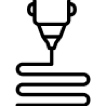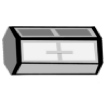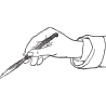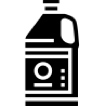Lots of companies from the traditional orthotics and prosthetics industry are turning to 3D printing technologies since 3D printed orthoses have several benefits over traditional orthoses.
Indeed, 3D printing allows the creation of unique devices so that the product fits the wearer perfectly.
Those custom-made 3D printing orthoses also offer an optimal comfort.
Also, by using a 3D body scan, a precise and perfectly fitting orthosis is manufactured and delivered within a very short period.
In addition, the additive manufacturing process significantly reduces the lead time of the orthosis solutions.
The design of the orthosis is then sent to a 3D printer mainly from SLS or MJF technology but also in some case white abs filament, which produces the device using materials such as a biocompatible polyamide or a soft tpu.
After the 3D printed orthosis has been produced, it is fitted to the user and any necessary functional adjustments or cosmetic finishes are made.
Once they are printed, the 3D printed orthopedic, orthotics and prosthesis devises can be dyed.
The coloration is an important step for the acceptation of the printed parts by the patient.
Tinting 3D printed orthotic or prosthetic devices can be done using specialized dyes that are formulated for use on 3D printed devices.
TCN formulates and offers such dyeing products and especially on demand color to fit perfectly the skin tone or any pantone or ral color wished.
This explains why, more and more 3D printed orthoses companies trust TCN and become loyal customers of both our dyeing products and process.
Indeed, they might need to dye 3D printed insoles or knee braces but also wrist supports or back supports as well as collars, helmets, foot orthoses, and prosthetic socket ….
Thanks to our liquid dyes, the 3D printing orthotics and prosthetists companies can color most of polymers from the polyamide to tpu as well as carbon fiber and much more.
Moreover, our coloring products can be used with almost all 3D print technologies such as MJF or SLS and FDM for example.
Our liquid dyes provide outstanding levels of fastness to rubbing, washing, bleaching, perspiration and light.
Our dyeing process is an easy-to-use and quick one.
It is based on dyeing bath which, once heated, will bring a stable and uniform coloration.
Our process is a coloration by dipping of plastic parts meant for orthotics parts.
Use with our GTD liquid dyes diluted in water, adjustable from 40°C to 95°C depending on the type of plastic your orthotics devices to tint are made of.
All you need is a:
- Heating bath,
- Heating and circulating pump for an efficient stirring,
- Metering jerrycan.
Wait from few seconds to 5 minutes to get the perfect color match and then rinse your colored orthotics parts with clear water.
An infinity of colors are available by mixing for a customized design of the orthosis and prosthesis 3D manufacturing devices.
Thus, our dyes enable a bespoken design to meet the individual need of each wearer.
It is important to choose a dye that is suitable for use on the material of the 3D printed devices and to follow our instructions for applying them.
We recommend testing the dye by dipping on a small, inconspicuous area of the prosthesis before applying it to the entire device.
This step will ensure that our dyeing products adheres well and produces the desired result.
If you are having difficulty tinting your 3D printed device, you may want to consider seeking for assistance.
We can help you choose the right tint for your needs and provide guidance on the proper application techniques.
You have questions? Feel free to contact us about the dyeing of your additive manufacturing of orthoses and prostheses.”
























